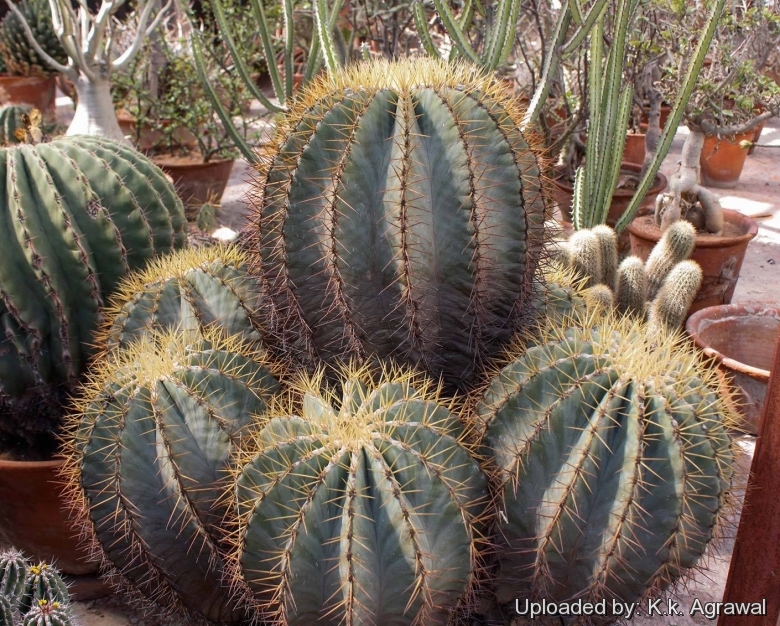
Ferocactus glaucescens Photo by: K.k. Agrawal
This Ferocactus stands out from the other species. The spines are rather neatly distributed, and the unusual-looking white fruits are unmistakable. Though it can reach over 45 cm in diameter, it will nonetheless flower perfectly well in an 20 cm pot. It can be a very neat, compact and attractive addition to any collection.
Origin and Habitat: Eastern central Mexico, Guanajuato, Querétaro, San Luis Potosí and Hidalgo (Meztitlan, Toliman and Jacala)
Altitude: Around 550 to 2300 metres in elevation.
Habitat: This species is found in deciduous dry forests and dry shrubland habitats on limestone hills and boulders. It is quite common in several locations in the state of Hidalgo, Mexico where has been noted to favour the more northern slopes, and the plants are well associated with the rocky, juniper woodland community. This species is also locally abundant in appropriate habitat in Querétaro, but in Guanajuato it is uncommon. Ferocactus glaucescensSN|1532]]SN|1532]] is considered not threatened due to its relatively widespread and abundant subpopulations, because there are no major threats, and because it occurs in several protected areas, however locally subpopulations are declining due to land use change.
Synonyms:
See all synonyms of Ferocactus glaucescens
back
Accepted name in llifle Database:Ferocactus glaucescens (DC.) Britton & RoseCactaceae (Britton & Rose) 3: 137. 1922Synonymy: 13
Cultivars
(1):
back
Common Names include:
LITHUANIAN (Lietuvių): Melsvasis ferokaktusas
SWEDISH (Svenska): Blågrön djävulstunga
Description: Ferocactus glaucescensSN|1690]]SN|1532]] is a medium sized solitary or basally suckering, barrel cactus. Multiple heads are produced as the plant ages and can form a very large mound. This species is sometimes confused with Ferocactus echidneSN|1532]]SN|1690]] (DC.) Britton & Rose and may even hybridize with that species.
Stems: Glaucous grey, up to 55 cm in height, 50 cm in diameter. Globular depressed at the apex, it becomes shortly columnar as it ages.
Ribs: 11 to 15
Radial spines: 6 or 7, 2.5-4 cm long, straight, light yellow.
Central spines: 0 or 1, very similar to the radials.
Flowers: Lemon yellow, funnel-shaped, 3-4 cm in diameter. The tepals are oblong, lanceolate, silky, shining, the margins are finely fringed. Stamen, style and stigma are yellow. Stigma lobes 12-15.
Blooming season: Late spring and summer. The flowers last a very long time. The plants start flowering when about 13 cm in diameter.
Fruits: White, 2 cm long with the remnants of the flowers attached.
Subspecies, varieties, forms and cultivars of plants belonging to the Ferocactus pottsii complex
(This Taxon belong to a group of six closely allied species. The group is: Ferocactus alamosanus, Ferocactus schwarzii, Ferocactus reppenhagenii, Ferocactus glaucescens, & Ferocactus echidne)
Bibliography: Major references and further lectures
1) Edward Anderson “The Cactus family” Timber Press, Incorporated, 2001
2) James Cullen, Sabina G. Knees, H. Suzanne Cubey "The European Garden Flora Flowering Plants: A Manual for the Identification of Plants Cultivated in Europe, Both Out-of-Doors and Under Glass" Cambridge University Press, 11/Aug/2011
3) David R Hunt; Nigel P Taylor; Graham Charles; International Cactaceae Systematics Group. "The New Cactus Lexicon" dh books, 2006
4) N. L. Britton, J. N. Rose “The Cactaceae. Descriptions and Illustrations of Plants of the Cactus Family.” Volume 4, The Carnegie Institution of Washington, Washington 1923,
5) Sánchez , E., Guadalupe Martínez, J. & Bárcenas Luna, R. 2013. Ferocactus glaucescens. In: IUCN 2013. "IUCN Red List of Threatened Species." Version 2013.2. <www.iucnredlist.org>. Downloaded on 23 February 2014.
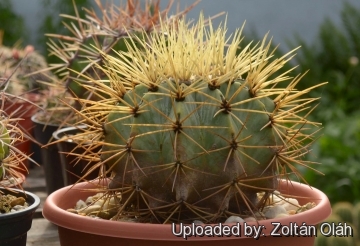 Ferocactus glaucescens Photo by: Zoltán Oláh
Ferocactus glaucescens Photo by: Zoltán Oláh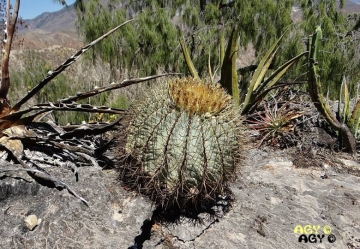 In habitat, Querétaro, Mexico. Photo by: Agócs György
In habitat, Querétaro, Mexico. Photo by: Agócs György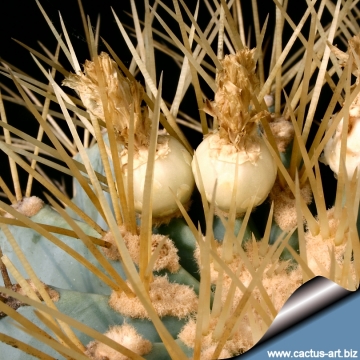 Ferocactus glaucescens Photo by: Cactus Art
Ferocactus glaucescens Photo by: Cactus Art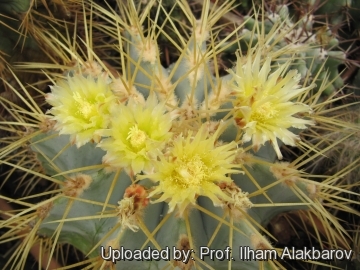 Ferocactus glaucescens Photo by: Prof. Ilham Alakbarov
Ferocactus glaucescens Photo by: Prof. Ilham Alakbarov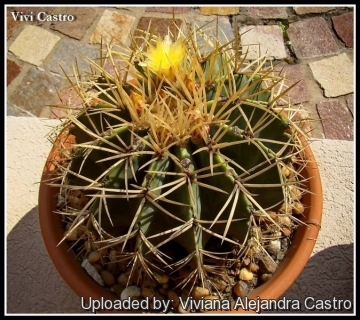 Ferocactus glaucescens Photo by: Viviana Alejandra Castro
Ferocactus glaucescens Photo by: Viviana Alejandra Castro Ferocactus glaucescens Photo by: Valentino Vallicelli
Ferocactus glaucescens Photo by: Valentino Vallicelli Ferocactus glaucescens Photo by: Valentino Vallicelli
Ferocactus glaucescens Photo by: Valentino Vallicelli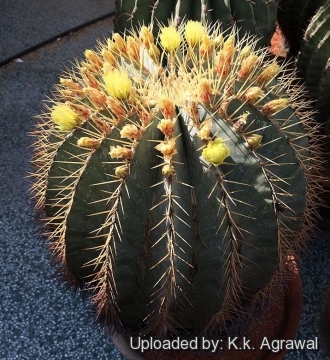 Ferocactus glaucescens Photo by: K.k. Agrawal
Ferocactus glaucescens Photo by: K.k. AgrawalCultivation and Propagation: Plants are slow growing to start, but are easy to grow and require little care once they have reached a nice flowering size. F. glaucescens is suited for any rich, well drained soil in full sun, through-out the year. Pot culture: It grows best in a fairly roomy, well-drained container filled with a porous cactus soil mixture that doesn't contain too much humus. To insure robust plants, water and fertilize during the aestival growth cycle. This plant needs plenty of water (indicatively, about once a week). But it's necessary to avoid wetting the bodies of these plants while they are in sunlight. A wet cactus in the sun light can cause sun burning which can lead to scars, or even fungal infections and death. In winter keep completely dry at 10°C. This usually aids in maintaining a healthier plant, but it can tolerate sporadic light frost.
Propagation: Seeds are the typical way of reproducing. These cacti will easily grow from seeds and some from cuttings. Seeds can be sown in the spring or summer in well-drained pots of soil for cacti. Sow the seeds thinly on top. Cover them with a bit of fine quartz grit. Moisten and lay a piece of glass across the top. The pots should be set in a warm greenhouse until they start to sprout, after which the glass should be progressively removed so they can receive full light and air. It isn't good to keep the glass over the seedlings. The well developed seedlings can be planted separately in small pots.
Cuttings made from pieces of the stem of any size can be detached and laid aside for a few days to allow a protective "skin" to form over the cut. They can then be planted in pots. Place them in a spot where they'll receive sun, and do not water until the soil becomes fairly dry. After a while the soil can be moistened regularly, but never kept constantly saturated.
Your Photos
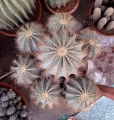
by K.k. Agrawal

by K.k. Agrawal
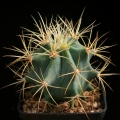
by Valentino Vallicelli
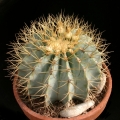
by Valentino Vallicelli

by Viviana Alejandra Castro























